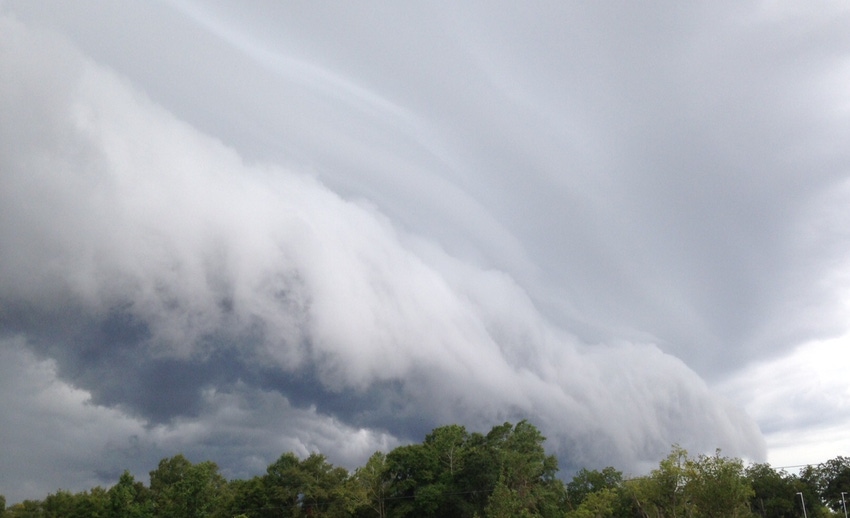
Late-season disease management decisions are often confusing, but they become even more frustrating when severe weather threatens.
From “Trying to reason with hurricane season” off his A1A album, Jimmy Buffet sings, “Well, the wind is blowin' harder now, 50 knots or there abouts. There's white-caps on the ocean and I'm watching for water spouts. It's time to close the shutters; it's time to go inside……..”
Unfortunately for farmers, parking the tractor and heading to the house is not possible when there is a crop in the field. As the trauma of Hurricane Harvey lingers in Texas and Louisiana and as Hurricane Irma hurtles eastward with landfall possible next week, growers are understandably anxious. Best management decisions are critical as growers race to beat late-season diseases and possible impact of another monster storm.
Late-season diseases are a threat to our row crops in 2017. Rust and other foliar diseases affect the soybean crop; target spot, bacterial blight and areolate mildew continue to develop in our cotton crop and white mold (stem rot) and leaf spot diseases threaten the peanut crop. The best management strategy is one which slows disease development and results in significant increase in value to the crop. To make the best decision, growers should consider several factors.
“How much time is left in the season?” and the related question, “What is the growth stage of the crop?” are the first factors to consider. Once soybeans reach the R6 growth stage where the seeds inside the pods are full-sized, it becomes game over for disease. For producers outside of the gulf coastal areas, I believe that beans at the R4-R5 stages are safe as well as it will take time for rust to reach damaging levels.
Many cotton growers have asked about fungicides to protect against target spot and, more recently, areolate mildew. Any benefits from fungicides on cotton become much less certain as crop develops beyond the sixth week of bloom. Open bolls in the bottom of the plant and fully mature (yet unopened) bolls at the top of the plant are indicative that the crop is beyond a stage where yield will be affected by disease.
Making end-of-season disease management decisions is most challenging for peanut growers. Reasons for this include the uncertainty in determining a best digging date, difficulties in assessing a disease like underground white mold and the multitude of products that could be sprayed on the crop. Generally speaking, a fungicide program should cover all peanut crops to within four weeks prior to the anticipated digging date. Fungicide programs for a field of peanuts with less than four weeks to go before digging should be tailored to the variety planted (level of disease resistance), disease in the field and pre-harvest intervals for fungicides under considerations. For example, a number of fungicides can be applied within 14 days of harvest, while others are labeled for 30 and even 40 days prior to harvest.
“How much disease is in the field now?” is another critical factor in determining how best to wrap up a management program. Finding out how much disease is in a field requires boots in the field; driving by and looking at field is not sufficient. Little or no disease late in the season is a good indication that a fungicide program can be suspended and that further applications are unlikely to have impact on yield.
Significant disease late in the season, observed as abundant defoliation, widespread wilted or dying plants, or simply as “spots from the top of the plant to the bottom of the plant” likely indicate that disease has progressed to such a degree that any further use of a fungicide will have no impact on the disease or on an increase in yield.
For peanut growers, significant late-season disease in a field could affect pod loss at digging and should be factored into determining the best date to dig the peanuts. In general, I recommend waiting to dig peanuts until they reach optimal maturity. Loss of grade can be more of a concern than digging losses accrued by waiting. This is especially true when one is considering impact of tomato spotted wilt but is less certain with leaf spot or white mold.
“What is the potential for some event, especially a weather event, to delay harvest?” Delays can magnify the impact of disease on a crop. Delays in harvest do not change my recommendations for management of a crop that has progressed beyond a vulnerable growth stage nor do delays affect recommendations for a crop affected by disease beyond hope. However, where anticipated delays in harvest, or in getting back into a field a likely, it is prudent to consider protecting a vulnerable crop ahead of the storm.
In helping Extension agents to develop recommendations for growers, I consider time to harvest, crop growth stage, disease in the field and possible delays in harvest. I tend to be aggressive in use of fungicides, likely because my biggest mistakes have occurred when I was hesitant to encourage a grower to spend more money on a fungicide.
In another favorite Buffett song, Jimmy sings, “He went to Paris looking for answer to questions that bothered him so…..” There is good news for row-crop growers, as they won’t need to travel to Paris for answers. Management recommendations are available as close as your county Extension office.
About the Author(s)
You May Also Like






